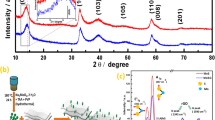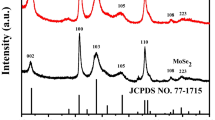Abstract
The search for high capacity, low-cost electrode materials for lithium-ion batteries is a significant challenge in energy research. Among the numerous potential candidates, layered compounds such as MoS2 (Molybdenum Disulfide) have attracted increasing attention. A facile hydrothermal reduction process using hexadecyltrimethy ammonium bromide (CTAB) as surfactant was developed for the synthesis of lithium-ion battery anode material MoS2 nanoflowers. The impact of CTAB on morphology and electrochemical performance of MoS2 has been investigated. With the increase of CTAB content, MoS2 ultrathin nanosheets with high specific surface area and more active sites have been successfully synthesized. Electrochemical measurements demonstrated that MoS2 nanoflowers synthesized with 1% content of CTAB have better electrochemical performance than others as anode materials for Li-ion batteries, which yield a high discharge capacity of 1245 mAh g−1 at a current density of 50 mA g−1 and a stable capacity retention of 740 mAh g−1 until 100 electrochemical cycles.









Similar content being viewed by others

References
A.S. Arico, P. Bruce, B. Scrosati, Nanostructured materials for advanced energy conversion and storage devices. Nat. Mater. 4, 366–377 (2005)
M. Chhowalla, H.S. Shin, G. Eda, The chemistry of two-dimensional layered transition metal dichalcogenide nanosheets. Nat. Chem. 5, 263–275 (2013)
E. Stura, C. Nicolini, New nanomaterials for light weight lithium batteries. Anal. Chim. Acta 568, 57–64 (2006)
J. Wang, C. Zhang, F. Kang, Nitrogen-enriched porous carbon coating for manganese oxide nanostructures toward high-performance lithium-ion batteries. ACS Appl. Mater. Interfaces 7, 9185–9194 (2015)
H. Wang, H.B. Feng, J.H. Li, Graphene and graphene-like layered transition metal dichalcogenides in energy conversion and storage. Small 10, 2165–2181 (2014)
X.L. Li, Y.D. Li, MoS2 nanostructures: synthesis and electrochemical Mg2+ intercalation. J. Phys. Chem. B 108, 13893–13900 (2004)
C. Feng, J. Ma, H. Li, R. Zeng, Z. Guo, H. Liu, Synthesis of molybdenum disulfide for lithium ions battery applications. Mater. Res. Bull. 44, 1811–1815 (2009)
H. H.wang, H. Kim, J. Cho, MoS2 nanoplates consisting of disordered graphene-like layers for high rate lithium battery anode materials. Nano Lett. 11, 4826–4830 (2011)
X.S. Zhou, L.J. Wan, Y.G. Guo, Synthesis of MoS2 nanosheet-graphene nanosheet hybrid materials for stable lithium storage., Chem. Commun. 49, 1838–1840 (2013)
S. Ding, D. Zhang, J.S. Chen, X.W. Lou, Facile synthesis of hierarchical MoS2 microspheres composed of few-layered nanosheetsand their lithium torage properties., Nanoscale. 4, 95–98 (2012)
H. Li, W.J. Li, L. Ma, W.X. Chen, J.M. Wang, Electrochemical lithiation/delithiation performances of 3D flower-like MoS2 powders prepared by ionic liquid assisted hydrothermal route. J. Alloys Compd. 471, 442 – 447 (2009)
W. Liu, S. He, T. Yang, Y. Feng, G. Qian, J. Xu, TEOS-assisted synthesis of porous MoS2 with ultra-small exfoliated sheets and applications in dye-sensitized solar cells. Appl. Surf. Sci. 313, 498–503 (2014)
P. Afanasiev, G.F. Xia, G. Berhault, B. Jouguet, M. Lacroix, Surfactant-assisted synthesis of highly dispersed molybdenum sulfide. Chem. Mater. 11, 3216–3219 (1999)
N. Berntsen, T. Gutjahr, L. Loeffler, J.R. Gomm, R. Seshadriand, W. Tremel, A solvothermal route to high-surface-area nanostructured MoS2. Chem. Mater. 15, 4498–4502 (2003)
S. Liang, J. Zhou, J. Liu, A. Pan, Y. Tang, PVP-assisted synthesis of MoS2 nanosheets with improved lithium storage properties. CrystEngComm 15, 4998–5002 (2013)
P. Sun, W. Zhang, X. Hu, L. Yuan, Y. Huang, Synthesis of hierarchical MoS2 and its electrochemical performance as an anode material for lithium-ion batteries. J. Mater. Chem. A 2, 3498–3504 (2014)
S. Hu, W. Chen, J. Zhou, F. Yin, E. Uchaker, Preparation of carbon coated MoS2 flower-like nanostructure with self-assembled nanosheets as high-performance lithium-ion battery anodes. J. Mater. Chem. A 2, 7862–7872 (2014)
K. Zhang, H.J. Kim, X.J. Shi, J.T. Lee, J.M. Choi, M.S. Song, J.H. Park, Graphene/acid coassisted synthesis of ultrathin MoS2 nanosheets with outstanding rate capability for a lithium battery anode., Inorg. Chem. 52, 9807–9812 (2013)
P. Sun, W.X. Zhang, X.L. Hu, L.X. Yuan, ,Y.H. Huang, Synthesis ofhierarchical MoS2and its electrochemical performance as an anode material for lithium-ion batteries. J. Mater. Chem. A 2, 3498–3504 (2014)
D. Xie, D.H. Wang, W.J. Tang, Binder-free network-enabled MoS2-PPY-rGO ternary electrode for high capacity and excellent stability of lithium storage. J. Power Sources 307, 510–518 (2016)
J.W. Zhou, J. Qin, X. Zhang, C.S. Shi, E.Z. Liu, J.J. Li, C.N. He, 2D space-confined synthesis of few-layer MoS2 anchored on carbon nanosheet for lithium-ion battery anode. ACS Nano 9, 3837–3848 (2015)
C. Zhu, X. Mu, P.A. van Aken, Fast Li storage in MoS2-graphene-carbon nanotube nanocomposites: advantageous functional integration of 0D, 1D, and 2D nanostructures. Adv. Energy Mater. 4, 5 (2015)
X.D. Xu, W. Liu, Y. Kim, J. Cho, Nanostructured transition metal sulfides for lithium ion batteries: progress and challenges. Nano Today 9, 604–630 (2014)
J. Wang, J.L. Liu, D.L. Chao, J.X. Yan, J.Y. Lin, Z.X. Shen, Self-assembly of honeycomb-like MoS2 nanoarchitectures anchored into graphene foam for enhanced lithium-ion storage[J]. Adv. Mater. 26, 7162–7169 (2014)
U.K. Sen, S. Mitra, High-rate and high-energy-density lithium-ion battery anode containing 2D MoS2 nanowall and cellulose binder[J]. ACS Appl. Mater. Interfaces 5, 1240–1247 (2013)
J. He, Y. Chen, P. Li, Self-assembled CoS2 nanoparticles wrapped by CoS2-quantum-dots-anchored graphene nanosheets as superior-capability anode for lithium-ion batteries[J]. Electrochim. Acta 182, 424–429 (2015)
X.F. Qian, Y.R. Wang, W. Zhou, L.P. Zhang, G.S. Song, S.Q. Cheng, Interlayer distance dependency of lithium storage in MoS2 as anode material for lithium-ion batteries. Int. J. Electrochem. Sci. 10, 3510–3517 (2015)
C.P. Veeramalai, F.S. Li, H.Y. Xu, T.W. Kim, T.L. Guo, One pot hydrothermal synthesis of graphene like MoS2 nanosheets for application in high performance lithium ion batteries. RSC Adv. 5, 57666–57670 (2015)
J. Shao, Q.T. Qu, Z.M. Wan, T. Gao, Z.C. Zuo, H.H. Zheng, From dispersed microspheres to interconnected nanospheres: carbon-sandwiched monolayered MoS2 as high-performance anode of li-ion batteries. ACS Appl. Mater. Interfaces 7, 22927–22934 (2015)
T. Stephenson, Z. Li, B. Olsen, D. Mitlin, Lithium ion battery applications of Molybdenum disulfide (MoS2) nanocomposites. Energy Environ. Sci. 7, 209–231 (2014)
Z.C. Wu, B. Li, Y.J. Xue, J.J. Li, Y.L. Zhang, F. Gao, Fabrication of defect-rich MoS2 ultrathin nanosheets for application in lithium-ion batteries and supercapacitors. J. Mater. Chem. A 3, 19445–19454 (2015)
N. Plylahan, C. Vidal-Abarca, P. Lavela, J.L. Tirado, The influence of iron substitution on the electrochemical properties of Li1+xTi2–xFex(PO4)3/C composites as electrodes for lithium batteries. Electrochim. Acta 22, 21602–21607 (2012)
L. Yin, J. Wang, F. Lin, J. Yang, Y. Nuli, Polyacrylonitrile/graphene composite as a precursor to a sulfur-based cathode material for high-rate rechargeable Li–S batteries. Energy Environ. Sci. 5, 6966–6972 (2012)
W.J. Zhou, Z.Y. Yin, Y.P. Du, X. Huang, Z.Y. Zeng, Z.X. Fan, H. Liu, J.Y. Wang, H. Zhang, Synthesis of few-layer MoS2 nanosheet-coated TiO2 nanobelt heterostructures for enhanced photocatalytic activities. Small 9, 140–147 (2013)
H. Jiang, D.Y. Ren, H.F. Wang, Y.J. Hu, S.J. Guo, H.Y. Yuan, P.J. Hu, L. Zhang, C.Z. Li, Batteries: 2D monolayer MoS2-carbon inter over lapped superstructure: engineering ideal atomic interface for lithium ion storage. Adv. Mater. 27, 3687–3695 (2015)
L. Shyyko, V. Kotsyubynsky, I. Budzulyak, M. Rawski, Y. Kulyk, R. Lisovski, Synthesis and double-hierarchical structure of MoS2/C nanospheres. Phys. Status Solidi 212, 2309–2314 (2015)
H. Liu, X.J. Chen, X. Su, C.Y. Duan, K. Guo, Z.F. Zhu, Flower-like MoS2 modified reduced graphene oxide nanocomposite: synthesis and application for lithium-ion batteries and mediator-free biosensor. J. Electrochem. Soc. 1629, 312–318 (2015)
Acknowledgements
This research has been supported by the Natural Science Foundation of Jilin Province (No. 20170101128JC), the Science and Technology Research Project of the Education Department of Jilin Province during the 13th 5-year plan period (no. 2016-359), the Youth Foundation of Changchun University of Science and Technology (no. XQNJJ-2014-13, XJJLG-2014-10), and the Science and Technology Planning Project of Changchun City (no. 2013064).
Author information
Authors and Affiliations
Corresponding author
Rights and permissions
About this article
Cite this article
Zhang, H., Cong, L., Wang, J. et al. Impact of CTAB on morphology and electrochemical performance of MoS2 nanoflowers with improved lithium storage properties. J Mater Sci: Mater Electron 29, 3631–3639 (2018). https://doi.org/10.1007/s10854-017-8293-4
Received:
Accepted:
Published:
Issue Date:
DOI: https://doi.org/10.1007/s10854-017-8293-4



